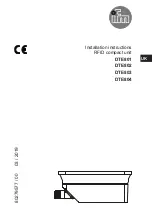Appendix B: Transmitter Installation
iConnect
Installation Manual
105
Actions to take when Alarm Sounding
In case of harmful levels of gas being detected, your detector will go into a continuous full alarm. Try to take the
following necessary actions immediately or evacuate the building:
•
Widely open doors and windows
•
Disconnect electrical appliances
•
Avoid open fire
•
Repair the gas leak by a professional gas repairer
Actions to take after the Problem Is Corrected
Once the problem about the gas presence in the premises has been corrected, the alarm of the detector should be off. After
waiting for 10 minutes, push the Test button to test the detector so that you can make sure that the detector is working
properly again.
Carbon Monoxide Detector (EL-4764)
The EL-4764 is a 2-Way Wireless Carbon Monoxide Detector (CO) used to detect the buildup of Carbon Monoxide. Upon
detecting the CO gas, the unit emits an alarm and notifies the control panel.
Things you should know about Carbon Monoxide
Carbon monoxide, also known as "CO" by the chemical form, is considered to be a highly dangerous poisonous gas,
because it is colorless, odorless, tasteless and very toxic. In general, biochemistry phenomena have shown that the
presence of CO gas inhibits the blood's capacity to transport oxygen throughout the body, which can eventually lead to
brain damage.
In any closed space (home, office, recreational vehicle or boat) even a small accumulation of CO gas can be quite
dangerous.
Although many products of combustion can cause discomfort and adverse health effects, it is CO gas which presents the
greatest threat to life.
Carbon monoxide is produced by the incomplete combustion of fuels such as natural gas, propane, heating oil, kerosene,
coal, charcoal, gasoline, or wood. The incomplete combustion of fuel can occur in any device which depends on burning
for energy or heat such as furnaces, boilers, room heaters, hot water heaters, stoves, grills, and in any gasoline powered
vehicle or engine (e.g. generator set, lawnmower). Tobacco smoke also adds CO to the air you breathe.
When properly installed and maintained, your natural gas furnace and hot water heater do not pollute your air space
with CO. Natural gas is known as a "clean burning" fuel because under correct operating conditions, the combustion
products are water vapor and carbon dioxide (CO2), which is not toxic. The products of combustion are exhausted from
furnaces and water heaters to the outside by means of a fuel duct or chimney.
Correct operation of any burning equipment requires two key conditions:
•
An adequate supply of air for complete combustion.
•
Proper venting of the products of combustion from the furnace through the chimney, vent or duct to the
outside.
Typical carbon monoxide gas problems are summarized here:
•
Equipment problems, due to defects, poor maintenance, damaged and cracked heat exchangers
•
Collapsed or blocked chimneys or flues, dislodged, disconnected or damaged vents
•
Downdraft in chimneys or flues. This can be caused by very long or circuitous flue runs, improper location
of flue exhaust or wind conditions
•
Improper installation or operation of equipment, chimney or vents
•
Air tightness of house envelop/inadequate combustion of air
•
Inadequate exhaust of space heaters or appliances
•
Exhaust ventilation/fireplace competing for air supply
Potential sources of carbon monoxide in your home or office include clogged chimney, wood stove, wood or gas
fireplace, automobile and garage, gas water heater, gas appliance, gas or kerosene heater, gas or oil furnace and cigarette
smoke.
Summary of Contents for iconnect
Page 79: ...Appendix A Menu Structure iConnect Installation Manual 75 ...
Page 80: ...Appendix A Menu Structure iConnect Installation Manual 76 ...
Page 81: ...Appendix A Menu Structure iConnect Installation Manual 77 ...
Page 82: ...Appendix A Menu Structure iConnect Installation Manual 78 ...
Page 83: ...Appendix A Menu Structure iConnect Installation Manual 79 ...
Page 84: ...Appendix A Menu Structure iConnect Installation Manual 80 ...


















